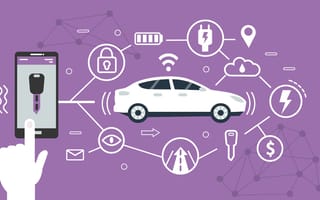These days, computer chips and sensors are lodged inside everything from washing machines to light bulbs to workout attire. But few industries are being transformed by the mass connect-ification of objects, aka the Internet of Things, like car manufacturing.
What Is a Connected Car?
Internet- and cloud-connected cars vacuum up and transmit heaps of data — between 20 to 200 megabytes per day, according to Darren Mann, vice president of global operations at Seattle-based Airbiquity, which has been used by the likes of GM, Ford and Toyota. That data is then used to design safer roadways, predict equipment malfunction and improve the in-car entertainment experience. In 2022, Micron released a 1.5 terabyte SD card that can provide connected cars with even more data storage opportunities.
Benefits of IoT In the Automotive Industry
Remote Software Updates
Connected cars are simplifying life for both drivers and manufacturers — especially when it comes to software upgrades.
“Vehicles have become increasingly more complex over time,” Mann said. “Traditionally, the only way to update cars that came off the factory line was by returning them to a dealer. Obviously that’s not only an inconvenience for the consumer, [it] becomes very costly for the car manufacturer.”
Thanks to IoT-connectivity, a car’s many software-reliant components can be updated “over the air.” Mann said a non-working headset, for example, is more likely to require an over-the-air software update rather than a trip to the manufacturer. Even a vehicle’s electronic control units are remotely updatable.
OTAs can enhance vehicle performance too. Serial software-updater Tesla, has sent OTA software fixes for everything from battery performance to suspension lifts.
Mann predicts that other automotive IoT developments will include more updates that are specifically related to features enhancement and offered via a pay-as-you-go subscription model. A provider could remotely pipe in, say, Audible’s audiobook service if a driver is taking a long vacation and traveling by car.
Changing technology means staying on top of new liabilities — and being able to deploy fixes with the click of a button rather than dealing with issues case by case. When a new vulnerability is identified, Mann said, IoT-connected onboard software lets manufacturers “immediately distribute a patch that addresses that vulnerability in a matter of days or minutes.”
Predictive Maintenance
One of the great promises of automotive IoT is predictive maintenance. A constellation of computer chips and sensors placed throughout a connected car collect performance data, which is processed in the cloud to predict when a part might require maintenance long before it gives up the ghost.
In a truly connected environment, a driver could even pass along a maintenance alert to the manufacturer or mechanic. The most complex systems would incorporate AI to give the predictive algorithm even greater forecasting powers.
Predictive maintenance can lower costs for consumers with its ability to collect data and the potential to adjust car settings to prevent wear and tear over time. It could also save dealerships and mechanics money too by working to optimize inventory management with notifications about upcoming repairs.
Making Parking Easier
American drivers spend on average a whopping 17 hours per year looking for parking. That’s a collective annual cost of $73 billion in time, fuel and emissions loss. Automotive IoT could help combat the time and money drivers spend on parking. The potential for connected cars to make parking easier is being recognized by the market too, with smart parking predicted to be valued at more than $16 million by 2028.
Using mapping data to find open parking spots can be done through companies like Otonomo, which inputs car data into the cloud and uses it for analysis of parking, traffic and more. Focusing on transportation planning in urban areas, the company offers a platform that city planners can use to measure parking availability and the duration of parking.
Infotainment
In nearly every new car produced today, there is a screen at the center of the dashboard — this is the vehicle’s infotainment system. With connected cars in-car entertainment, or infotainment, is another growing facet of the automotive IoT industry.
Infotainment systems can range from vehicle-specific systems like Kia’s UVO or Jeep’s Uconnect to mobile-compatible systems like Samsung's Exynos Auto and Android Auto. Some of the major perks of infotainment for drivers includes speech activated navigation, texting and calls. Connected cars and infotainment systems go hand in hand nowadays as infotainment systems couldn’t work without IoT connectivity.
The connected car allows for direct integration of vehicle audio systems with personal smart devices. Apple’s CarPlay, for instance, lets drivers make calls through the console and can add Spotify, Audible, Pandora and a host of other voice-enabled apps to the dashboard.
Traffic Prediction
Traffic is at best an inconvenience. At worst, it’s a breeding ground for crashes. An increasing number of IoT sensors in CCTV cameras and along highways and bridges constantly collect data to help alleviate traffic burdens and predict likely congestion points before they materialize. In order to more effectively achieve that goal, public safety agencies and IoT companies around the country have joined forces.
Connected cars are able to exchange information with each other, with the help of signal phase and timing information, cars with IoT capabilities are able to predict and report traffic patterns. Predicting traffic can help drivers travel more fuel efficiently and enhance safety on the road.
As more signal phase and timing data becomes available through connected cars, prediction will likely become more accurate. Autonomous vehicles are also paving the way for better traffic patterns and car connectivity. A simulation study found autonomous vehicles decreased travel time by 17 percent.
The Challenges Connected Cars Face
Data Security
As with any seismic technological shift predicated on gobbling up reams of data, automotive IoT isn’t without privacy concerns. For example, if data is being amassed on how fast you drive and how often you slam on the brakes, doesn’t it follow that your insurer would pay a pretty penny to see it?
Because car manufacturers generally control the data, Mann notes, consumers should educate themselves as much as possible.
“When you buy a car, you’re entrusting your automaker [with your information],” he said, and it’s the automaker’s responsibility “to make sure that they’re treating your data as they should be.”
At the same time, data privacy regulations are ramping up alongside increases in data collection and protection concerns. The California Consumer Privacy Act took effect in January 2020 and has the potential to become a de facto U.S. standard for automakers. Across the Atlantic, the General Data Protection Regulation has been in effect since 2018. It gives consumers greater control over their data and provides a framework for hefty fines against companies that breach protocol.
Connectivity Issues
Also in flux is the data connection itself. Car safety technology has improved with advancements like automatic emergency braking and blind spot monitoring, but it’s poised for a genuine breakthrough with vehicle-to-vehicle connectivity. For example, a driver might get an alert to slow down because a fellow motorist three or four vehicles ahead has slammed on the brakes. But that method of connection — whether 5G or WiFi — has yet to be standardized.
While that uncertainty might play a role in slowing full adoption, companies like Airbiquity that build connection-agnostic solutions will be ready either way.
“We developed a platform that enables [automakers] to use whatever channels are available,” Mann said. “So the technology isn’t going to be about any one particular predominant standard; it's more about making sure you can support multiple standards, and the beauty of the product.”
Operating Systems
The auto and tech industries haven’t always been fast friends when it comes to issues like infotainment cloud links and connected cars. Some liability-conscious automakers are hesitant to relinquish control of their systems to tech outsiders. Volkswagen is perhaps the most notable example; the German car manufacturer created its own operating system in house that was established in 2020. The VW.OS is supplied by CARIAD.
Volkswagen won’t be alone in its software development endeavors either. Automakers like Toyota and Mercedes-Benz are also jumping into the game.
“Historically — and this is probably not so prevalent in today’s industry — car manufacturing really wasn’t about software,” Mann said. “The mindset change that’s happened recently is that software development is part and parcel of that ecosystem.”
The original equipment manufacturers Mann’s company deals with, he added, “are fully involved in providing the best technology out there.”
While we wait for the full line of automotive IoT benefits to arrive, consumers already are enjoying lots of advantages.
“Just like connected devices in the house, people expect convenience and ease of use,” Mann said. “It’s just a natural progression for cars.”
Automotive IoT Companies
Location: Aurora, Ontario
Magna International makes technology for the automotive sector, including systems that enable connected cars. For example, the company’s multiple groups include Magna Electronics, which is working to develop solutions for connectivity and automated driving, such as systems that help guide vehicles safely into available parking spaces and mitigate distracted driving.
Location: Santa Clara, California
Telenav has developed cloud-integrated platforms that — along with direct access to audio apps, navigation and Amazon’s Alexa — add to the display personal environment controls for climate adjustment and seat heating. It’s all part of what Telenav executive director Ky Tang has called “the battle for the fourth screen.”
Location: Oak Brook, Illinois
If truckers are the backbone of America’s economy, fleet management is the ergonomic support. Companies like Bransys, which makes the EZtoTrack platform, help fleet managers keep track of the millions of tractor trailers on the road. In addition, cargo sensors monitor a trailer’s assets while also controlling the temperature for environment-sensitive cargo like fruits and vegetables. Along with electronic logging device options, the line also offers low-power-consumption IoT sensors that track motion and temperature.
Location: Chicago, Illinois
Chicago-based app-makers ParqEx connect owners of private garages with spot seekers through a mobile app. With no need to give out garage keys or leave doors unlocked, the process is facilitated by IoT sensors that open the garage or gate to paying users.
Location: Burlington, Massachusetts
Progress incorporates unsupervised machine learning into its anomaly detection. The technology helps automakers keep costs down too. A car manufacturer that was wrestling with rising operating costs due to a glut of warranty claims and sinking scores on customer loyalty metrics used the company’s predictive detection product. It built a predictive model using sensor-collected data that was able to alert drivers before issues developed.
Location: Redwood City, California
Analyzing traffic is no easy task, but having improved data can help. One of the firms helping lay this digital fabric, Waycare, partners with Otonomo to create a leading platform to connect cars to the cloud. This means that data from Otonomo’s connected cars helps fuel the system that lets emergency road crews respond more quickly and engineers plan roadways. And it’s a heap of data. Otonomo, which also partners with Mercedes-Benz, joined up with car rental company Avis Budget Group. The partnership is set to a bring more than 100,000 cars onto Otonomo’s platform.
Location: Amsterdam, the Netherlands
HERE Technologies is an international software company that supports development of location and mapping solutions for vehicles. Its platform offers access to tools and data that can power mapping capabilities for ADAS, or advanced driver assistance systems, as well as HAD, or highly automated driving, solutions.
Location: Sunnyvale, California
Sonatus aims to improve vehicle reliability and reduce costs through its platform that allows automakers to update, manage and monitor vehicle software remotely. The platform uses in-vehicle sensors to collect performance data, facilitate over-the-air enhancements and enable access to real-time data analysis.
Location: Detroit, Michigan
General Motors is one of the world’s largest automakers, employing more than 165,000 people globally. The company offers connected cars through its OnStar platform, along with built-in app integrations, Wi-Fi and over-the-air updates. This enables features like emergency assistance, vehicle diagnostics, real-time navigation and remote start.












